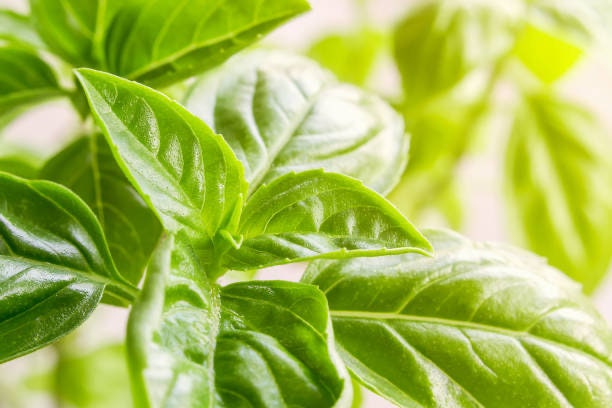My Store
Basil Genovese
Basil Genovese
Couldn't load pickup availability
0.5g ~300 seeds
Genovese basil, scientifically known as Ocimum basilicum 'Genovese,' is a popular variety of basil that originated in Italy. It is a cultivar of sweet basil and is well-known for its robust flavor, aromatic leaves, and culinary uses. Here's a detailed description of Genovese basil:
**Plant Characteristics:**
- **Height:** Genovese basil typically grows to a height of 18 to 24 inches (45 to 60 cm).
- **Foliage:** The leaves are large, bright green, and slightly serrated at the edges. They are highly aromatic, with a sweet and spicy aroma that intensifies when the leaves are crushed.
- **Flowers:** Genovese basil produces small, white to pale pink flowers in spikes. Pinching off the flowers before they bloom can encourage the plant to focus on leaf production, ensuring a more abundant harvest.
**Growing Conditions:**
- **Sunlight:** Genovese basil thrives in full sun, needing at least 6 to 8 hours of direct sunlight per day for optimal growth.
- **Soil:** It prefers well-draining, fertile soil with a slightly acidic to neutral pH. Amending the soil with compost or organic matter can enhance its growth.
- **Watering:** Keep the soil consistently moist but not waterlogged. Basil plants prefer even moisture and should be watered at the base to prevent water splashing on the leaves.
**Uses:**
- **Culinary:** Genovese basil is a staple ingredient in Italian cuisine, especially in pesto sauce. Its strong, sweet flavor makes it perfect for various dishes, including salads, sauces, and pasta.
- **Medicinal:** Basil, including Genovese basil, is known for its potential health benefits. It is rich in antioxidants and essential oils and is often used in traditional medicine for its antibacterial and anti-inflammatory properties.
- **Aromatherapy:** Basil essential oil extracted from the plant is used in aromatherapy for its calming and uplifting effects.
**Harvesting:**
- Genovese basil can be harvested once it has reached a height of 6 to 8 inches (15 to 20 cm). Harvest the leaves regularly to encourage bushier growth. Pinch off the tips and flower buds to prolong the plant's leaf production.
Genovese basil is not only valued for its culinary uses but also appreciated for its delightful fragrance and ease
Seed sowing instructions for basil:
1. **Gather Supplies:** You'll need basil seeds, a seed tray or pots, seed compost, a watering can, and labels.
2. **Fill the Tray or Pots:** Fill the seed tray or pots with seed compost, leaving a small gap at the top.
3. **Sow the Seeds:** Sprinkle the basil seeds evenly over the compost surface. Basil seeds are tiny, so be cautious not to sow them too densely.
4. **Cover the Seeds:** Gently press the seeds into the compost using a flat board or your hand. Then, lightly cover them with a thin layer of compost.
5. **Watering:** Water the seeds gently, ensuring the compost is moist but not waterlogged. You can use a fine spray or mist setting on your watering can to avoid disturbing the seeds.
6. **Provide Light:** Basil seeds need light to germinate. Place the seed tray or pots in a bright location, but not in direct sunlight.
7. **Maintain Moisture:** Check the moisture level regularly. The compost should be kept consistently moist, but again, avoid overwatering.
8. **Transplanting:** When the seedlings have developed a few sets of true leaves and are large enough to handle (usually when they're 2-3 inches tall), transplant them into individual pots or the garden if the weather is warm enough.
9. **Harden Off:** If you plan to plant basil outdoors, it's essential to harden off the seedlings by gradually exposing them to outdoor conditions. Start with a couple of hours a day and gradually increase the time over a week.
10. **Planting Outdoors (Optional):** If you're planting basil outdoors, choose a sunny spot with well-draining soil. Space the plants about 12-18 inches apart.
11. **Maintenance:** Water the basil plants regularly, especially during dry spells. Pinch off the tips regularly to encourage bushier growth and prevent flowering, which can make the leaves bitter.
Remember, basil is sensitive to cold temperatures, so if you're in a region with cold winters, you might want to consider growing it indoors or starting new plants from seeds each spring.
Multiple orders of a single item may be combined into 1 seed envelope unless otherwise instructed by buyer.
Multiple orders of a single item may be combined into 1 seed envelope unless otherwise instructed by buyer.We take great care to provide high-quality seeds, corms, and bulbs, all of which are tested for acceptable germination rates. However, because successful growth depends on various factors beyond our control—such as planting conditions, weather, and care—we cannot offer refunds for seeds, corms, or bulbs that do not germinate or sprout.
Thank you for your understanding and support. If you have any questions about planting or care, we’re happy to help!
Share









